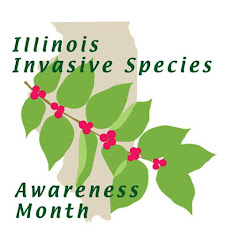Illinois Invasive Species Awareness Awards
Nomination Application
Presented by the Illinois Invasive Species Awareness Month Committee
 We will accept nominations for individuals, groups, and organizations for their exemplary efforts at addressing issues surrounding terrestrial and aquatic invasive species, including animals, pathogens, plants, and forest pests. Please consider nominating adults and youth that you work with or know who are worthy of this award.
We will accept nominations for individuals, groups, and organizations for their exemplary efforts at addressing issues surrounding terrestrial and aquatic invasive species, including animals, pathogens, plants, and forest pests. Please consider nominating adults and youth that you work with or know who are worthy of this award.
Award recipients will be announced in early May and will be recognized at an awards ceremony planned for May 2014 (details to follow). Award recipients will be announced in the news media and on the Invasive Species Awareness Month website www.illinoisinvasives.org.
To submit a nomination, please send a document with the following information:
Please send the requested information by April 1, 2014 to Chris Evans at chris.evans@illinois.gov, fax: 618-439-7376 or via regular mail to:
ISAM Award Nomination
c/o Chris Evans, 11731 State HWY 37, Benton IL 62812
All nominators and winners will be notified by May 1, 2014.
Nomination Application
Presented by the Illinois Invasive Species Awareness Month Committee
May is Invasive Species Awareness Month (ISAM) in Illinois. As part of the many activities that will be occurring throughout the month, the ISAM Committee will select Awardees, honoring Illinois citizens and organizations for their significant contribution to prevent or manage invasive species that harm Illinois’s land and water.
 We will accept nominations for individuals, groups, and organizations for their exemplary efforts at addressing issues surrounding terrestrial and aquatic invasive species, including animals, pathogens, plants, and forest pests. Please consider nominating adults and youth that you work with or know who are worthy of this award.
We will accept nominations for individuals, groups, and organizations for their exemplary efforts at addressing issues surrounding terrestrial and aquatic invasive species, including animals, pathogens, plants, and forest pests. Please consider nominating adults and youth that you work with or know who are worthy of this award.
Award recipients will be announced in early May and will be recognized at an awards ceremony planned for May 2014 (details to follow). Award recipients will be announced in the news media and on the Invasive Species Awareness Month website www.illinoisinvasives.org.
To submit a nomination, please send a document with the following information:
- Full contact information for nominee;
- Nomination category (Volunteer, Professional, Professional Business (for-profit), or Professional Organization (Not-for-Profit, governmental, or non-governmental);
- A summary statement including information about what the nominee has done to earn your nomination. Include the impact of the nominee’s actions, who and/or what benefits from those actions, why the group or individual’s contribution are significant, and the time period in which these actions occurred; and
- Geographical locations are impacted by the nominee’s action
ISAM Award Nomination
c/o Chris Evans, 11731 State HWY 37, Benton IL 62812
All nominators and winners will be notified by May 1, 2014.


